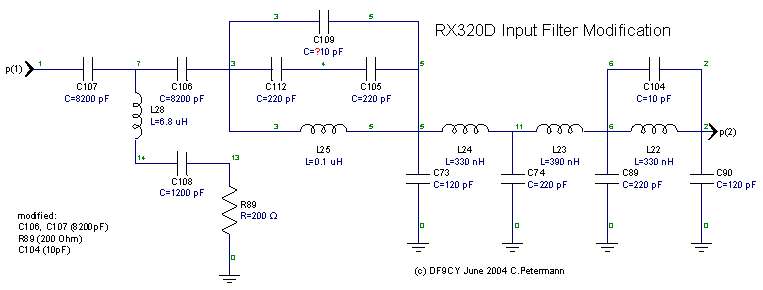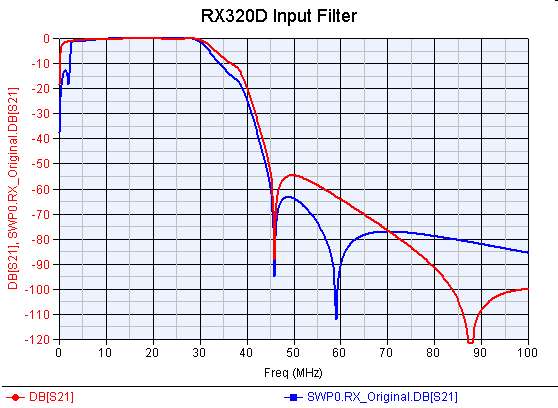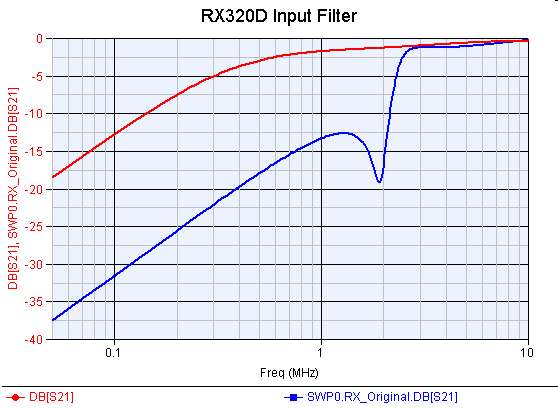
| Christoph Petermann | Homepage |
|
DF9CY
TenTec RX320D Receiver
|
Last Revision: 9 June 2004
Until June 2004 some modifications were made (see below). Meanwhile I use the RX320D as receiver for 144 MHz Moonbounce with a high-level converter and the LINRAD software running from the 12 kHz IF output. This is real great stuff and works phantastic. I provided several software developers with the radio programming data which is now implemented now in programs for DRM reception. (DREAM, DRM_Discoverer etc)
Directly to MODIFICATIONS
Best idea is you go to TenTec site, where you get access to the technical data and everything if you want to read the technical data of this radio..
I had to wait for quite a while - almost 6 weeks - but finally the long awaited package arrived from THIECOM (www.thiecom.de) on 29 July 2003. Everything was inside the package and well packed. The only unusable thing inside is the power supply which is designed for 110V only. But a good working one was in my ham-junkbox.
Setting up the whole receiver is easy and takes a few minutes only. I used two computer loudspeakers connected to the line-out socket. I first used the small telescopic antenna which can be screwed into the socket. After tuning to 1269 kHz I immediately copied the local (80km) Deutschlandfunk with very good audio. But when tuning around I heard all this noise from the close-by Notebook. I placed a ferrite core to the RS232 cable and this helped a lot. What could I receive ? It was already 10 at night at end of July 2003 and there where a number of BC (Broadcast) stations audiable on Longwave and Mediumwave.
The sound is very good but I hear the typical noise from DSP based receivers and decoders. Every DSP receiver I have listened to performed like this.
The software sets the basic functions and has some database operations. But I expected something better I must admit.
The performance with the supplied telescopic antenna - about 50 cm - is IMHO very poor. It picks up a lot of noise even my note book is RF wise "silent". It can be used as the least antenna, if nothing else can be put up.
Now it became time to plug my large antenna to the radio. What is my large antenna? I have a vertical rod which is attached isolated to the wall and its top is about 10 m high. I made a good grounding and additionally buried three 10m long radials in the earth below the lawn. I use the antenna for amateur radio at 160m, 80m, 40m and 30m bands. It is tuned to the bands with a homemade antenna tuner. For LW and MW the antenna can be coupled via a serial inductor or a parallel inductor directly to the receiver. I know it is a good performer on 7 MHz i.e. 40m.
The RX320D suffers from the high level signals but with a 10 dB attenuator in the input the performance improves significantly. I immediately did receive DX stations from JA (Japan) - Very impressive indeed. Good performance and very clean demodulation.
Longwave reception rather poor. This is confirmed by the sensitivity measurements. (See further down). Even while tuning the LW band, I can see the the increase in signal levels from 153 to 270 kHz. Even the worst car radio has better data.
Again the attenuator was necessary, but good performance all over. When the local PowerRadio612 switched off in the evening another station with some arabic sound was heard clearly.
Good performance with an attenuator in the evening crowling. Pleased with the performance.
The TenTec software does work fine but I do miss some functions like setting 9 kHz steps for AM reception. There is a bunch of software available on the Internet for Linux and Windows. I got stuck to AB9B Tom Lackamp (www.qsl.net/ab9b) Scan320 Programm.
The DSP sound does not seem to be a problem at all. No noise of the computer is heard now. Very nice. Yes, the receiver of my shortwave transceiver is better of course. But this I knew before purchase. The RX320D is BY FAR better than any "world receiver" I have had in my hands before - It is a different class.
On 30 July 2003 I finally received the Key-file for the DRM software radio. After the -easy- installation following the instructions I tuned the radio to Deutsche Welle at 6140 kHz. The IF output of the RX320D was connected to the line-in of the notebook. I immediately saw the DRM signal in the spectrum display of the program and after making the right settings for the audio channel of the soundinterface of the notebook I got a crystal clear audio sound ! What a success ! The SN reading was about 17 .. 22 dB. After this I tried some other stations that should be on-air at that time, but there was nothing until I came to 9855 kHz IBB Morocco with their just 6 kw transmitter. What a tremendous signal and excellent audio quality. While doing something else I listened for more than one hour and I believe there was no drop in signal at all. I must say that seems to be what I wanted this tiny radio for.
I found out that the IF-out port has too much output power. A small 22k potentiometer helped and increased SN from about 20 dB to 25 dB. It now decodes also on noisier signals.
Best ever received S/N with DRM has been 30 dB !
One problem I have found out is that the oscillator PLL operates down to 2.5 kHz steps. The finer tuning is done inside the DSP. This does mean as the DRM SoftwareRadio uses a fixed 12 kHz IF, no station with an "odd" frequency (i.e. 729 kHz) can be received. Only frequencies ending with a 0 or 5 do work. So this hampers with the 9 kHz steps used in Europe.
After several months of testing I must say, that the radio does a very fine job with DRM reception. I even placed everything in my car a tested DRM mobile.
I measured the sensitivity on the whole frequency range from 100 kHz to 30 MHz. Above about 2 MHz a good sensitivity can be seen, but below that it goes to as poor as 45 dBµV at 100 kHz. This is indeed not a good value and I will do some modification on the receiver as proposed further down here.
Sensitivity for USB was measured at 15 MHz and 10 dB S/N with 0.4 µV; what is a very good value !
Setup:
RX320D
Receive mode : AM
Bandwidth : 3.3 kHz
Target : 20 dB S/N in weighted CCIR filter (standard mode)
Measuring equipment
Generator : Rohde & Schwarz SML
Analyser : Rohde & Schwarz UPL Audio Analyser
Spectrum Analyser: Rohde & Schwarz FSH
The 12 kHz IF output has been checked with LINRAD and I can see that it is not that flat I would like to have it. Furthermore the RS232 signal produces noise on the IF output, which disappears, when the RS232 line is unplugged.
Next measurements will be IP3 (3rd order intercept point) and intermodulation. Coming soon !

I inserted a small 22k potentiometer (shielded) right behind the back panel at the IF-out port. Here it is easy to adjust the output voltage level. Simply set the PC soundcard line input level to a medium value. I then adjusted the potentiometer to an optimal S/N (Signal over Noise) level while receiving a DRM signal. This greatly improved performance ! The DRM software radio now decodes to much weaker signals and gives much better SN like "Deutsche Welle" on 6140 kHz increases from 21 dB S/N to 26 dB S/N. The correct value may differ from the soundcard you use. It shall not be overdriven what causes distortion and degrades performance.
I have found a modification described on the AMRAD RX320Mod page to improve performance on the very low bands from 100 kHz to 1 MHz.
After looking into the receiver I must say it looks different from the images in the article. There is an AMIDON ring core now. I will wait until I have done some measurements and I know the performance of the radio. (Meanwhile I know I have to do something ...)
Only sensitivity on Longwave is VERY poor. Mediumwave is hard at limits. When making the modification I fear bad intermodulation performance. We will see.
Here is an input filter modification, that will enhance Longwave and Mediumwave sensitivity by about 15dB. The only problem may be blocking and intermodulation with very strong signals. I did not suffer any degradation so far I can see today.

The values are changed so that the MW band attenuation is lowered. Also a notch has been moved from ca 60 MHz to the FM radio band. This gives a slight improvement on the 10 Meter band (28 .. 30 MHz) too.
The images below show the transmission of the filter red=new and blue=old.


I will add images of the modification here.
|
Text and All
Images are Copyright by Christoph Petermann DF9CY
|
GO (back) and visit my homepage